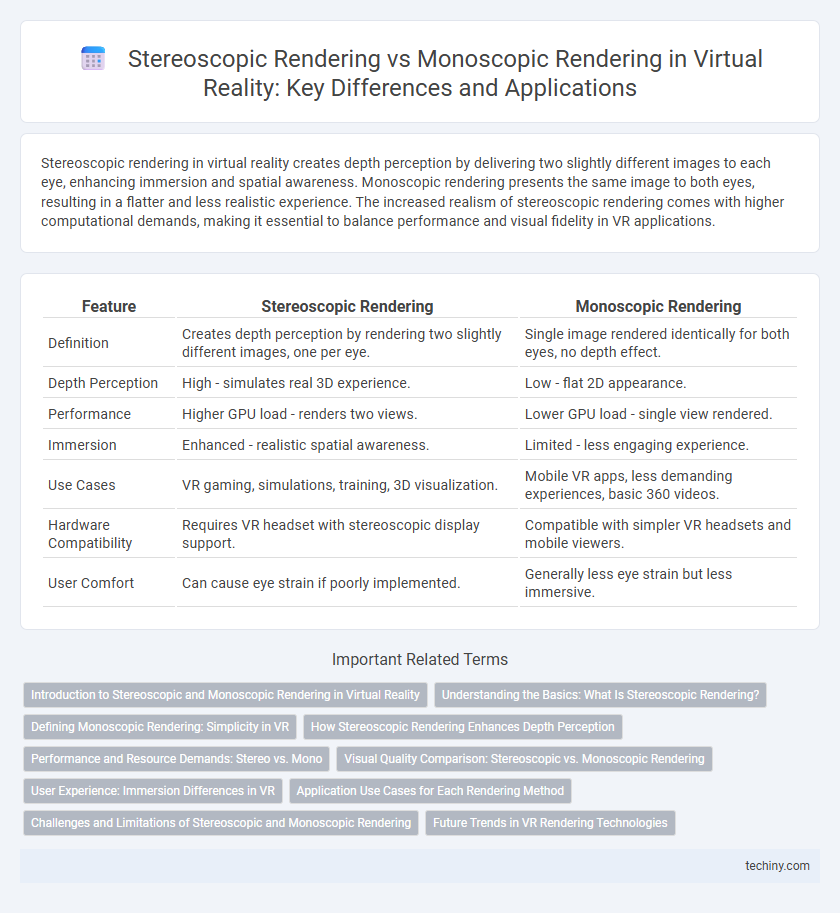Stereoscopic rendering in virtual reality creates depth perception by delivering two slightly different images to each eye, enhancing immersion and spatial awareness. Monoscopic rendering presents the same image to both eyes, resulting in a flatter and less realistic experience. The increased realism of stereoscopic rendering comes with higher computational demands, making it essential to balance performance and visual fidelity in VR applications.
Table of Comparison
| Feature | Stereoscopic Rendering | Monoscopic Rendering |
|---|---|---|
| Definition | Creates depth perception by rendering two slightly different images, one per eye. | Single image rendered identically for both eyes, no depth effect. |
| Depth Perception | High - simulates real 3D experience. | Low - flat 2D appearance. |
| Performance | Higher GPU load - renders two views. | Lower GPU load - single view rendered. |
| Immersion | Enhanced - realistic spatial awareness. | Limited - less engaging experience. |
| Use Cases | VR gaming, simulations, training, 3D visualization. | Mobile VR apps, less demanding experiences, basic 360 videos. |
| Hardware Compatibility | Requires VR headset with stereoscopic display support. | Compatible with simpler VR headsets and mobile viewers. |
| User Comfort | Can cause eye strain if poorly implemented. | Generally less eye strain but less immersive. |
Introduction to Stereoscopic and Monoscopic Rendering in Virtual Reality
Stereoscopic rendering in virtual reality creates depth perception by displaying two slightly different images for each eye, simulating human binocular vision and enhancing immersion. Monoscopic rendering presents a single image to both eyes, resulting in a flat visual experience without depth cues, which can reduce realism but requires less computational power. Understanding the differences between stereoscopic and monoscopic techniques is essential for optimizing VR applications based on performance and user experience goals.
Understanding the Basics: What Is Stereoscopic Rendering?
Stereoscopic rendering generates two distinct images, one for each eye, creating depth perception and a three-dimensional immersive experience in virtual reality environments. Monoscopic rendering, in contrast, produces a single flat image perceived identically by both eyes, lacking the depth cues essential for realistic VR immersion. Understanding stereoscopic rendering is crucial for developing VR applications that mimic real-world spatial awareness and enhance user presence.
Defining Monoscopic Rendering: Simplicity in VR
Monoscopic rendering in virtual reality displays a single 2D image to both eyes, creating a flat visual experience without depth perception. This technique requires less computational power compared to stereoscopic rendering, making it suitable for simpler VR applications and devices with limited hardware capabilities. By presenting one unified view, monoscopic rendering simplifies the rendering process while maintaining basic immersion in virtual environments.
How Stereoscopic Rendering Enhances Depth Perception
Stereoscopic rendering enhances depth perception by delivering two slightly different images to each eye, mimicking natural binocular vision and creating a convincing three-dimensional experience. This method allows the brain to accurately interpret spatial relationships and distances within virtual environments, improving immersion and interaction precision. Unlike monoscopic rendering, which presents a single flat image, stereoscopic rendering significantly reduces visual ambiguity and enhances realism in virtual reality applications.
Performance and Resource Demands: Stereo vs. Mono
Stereoscopic rendering requires rendering two separate images, one for each eye, effectively doubling the workload compared to monoscopic rendering, which creates a single image. This increased demand results in higher GPU utilization and can lead to reduced frame rates or the need for more powerful hardware to maintain smooth VR experiences. Monoscopic rendering, while less immersive, significantly reduces performance requirements and resource consumption, making it more suitable for lower-end VR systems or applications prioritizing efficiency over depth perception.
Visual Quality Comparison: Stereoscopic vs. Monoscopic Rendering
Stereoscopic rendering delivers enhanced visual quality by presenting slightly different images to each eye, creating a realistic depth perception that monoscopic rendering lacks. This technique significantly improves immersion in virtual reality environments by simulating natural binocular vision with accurate spatial cues. Monoscopic rendering, offering a single image for both eyes, often results in flat visuals, reducing depth realism and user engagement.
User Experience: Immersion Differences in VR
Stereoscopic rendering in virtual reality delivers two slightly different images to each eye, creating a compelling sense of depth and spatial awareness that significantly enhances user immersion. Monoscopic rendering presents the same image to both eyes, resulting in a flatter visual experience that diminishes the feeling of presence within the virtual environment. This fundamental difference affects user engagement, with stereoscopic rendering driving higher levels of immersion and realism essential for applications like gaming, training simulations, and virtual tours.
Application Use Cases for Each Rendering Method
Stereoscopic rendering is essential for immersive VR experiences such as gaming, training simulations, and architectural visualization, where depth perception and spatial awareness enhance user engagement. Monoscopic rendering suits applications like educational content, VR cinema, and simple 360-degree video playback, where performance efficiency and broader device compatibility are prioritized over depth cues. Choosing the appropriate rendering method depends on the balance between visual fidelity requirements and computational resource constraints in specific VR use cases.
Challenges and Limitations of Stereoscopic and Monoscopic Rendering
Stereoscopic rendering faces challenges such as increased computational load and higher latency, which can cause discomfort and motion sickness in VR users due to mismatched depth cues. Monoscopic rendering, while less taxing on hardware, restricts depth perception and immersion by presenting a single viewpoint, limiting spatial understanding and realism in virtual environments. Both methods struggle with accurately replicating natural vision, but stereoscopic rendering demands advanced hardware and optimization techniques to balance performance and user comfort.
Future Trends in VR Rendering Technologies
Stereoscopic rendering delivers depth perception by presenting two slightly different images to each eye, enhancing immersion in virtual reality environments, whereas monoscopic rendering displays a single image, limiting spatial realism. Emerging VR rendering technologies are moving towards advanced stereoscopic techniques combined with foveated rendering and real-time ray tracing to optimize performance while maintaining high visual fidelity. Future trends emphasize AI-driven rendering algorithms and neural radiance fields to create more realistic, adaptive, and resource-efficient virtual experiences.
stereoscopic rendering vs monoscopic rendering Infographic

 techiny.com
techiny.com